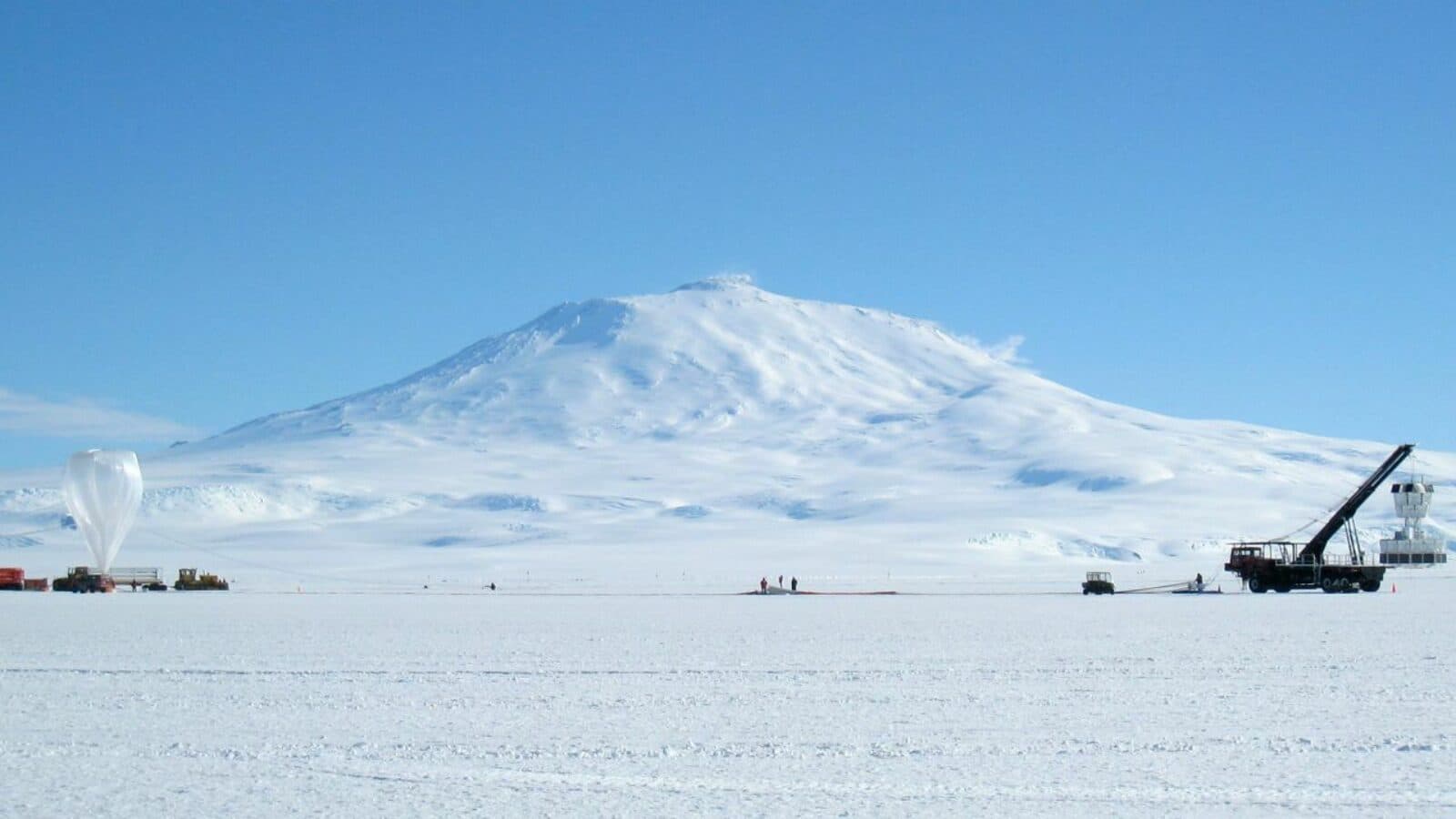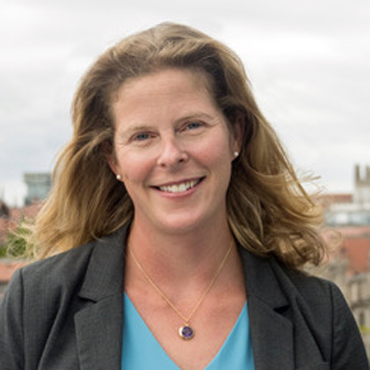Solving Astrophysical Problems by Hand
by Adam Hadhazy
Abigail Vieregg, director of the Kavli Institute for Cosmological Physics, shares her passion for building experiments and bringing people together to solve scientific mysteries

The Author
Many scientists recall that moment, usually in childhood, that set them on a direct path to their eventual field of study—that first time they looked through a telescope, for instance, or their first time visiting a natural history museum.
Abigail Vieregg's scientific origin story is not quite so linear. When thinking back on her roots as a researcher, she instead recalls tinkering in a garage as a child with her grandmother, who kept a big workbench full of hand tools.

"I remember just building stuff with her," says Vieregg. "We built a sailboat together, but I'm sure it could've only gone downwind and not upwind. I mean, I was probably eight!"
What Vieregg did take away from these sessions, though, was an interest in working with her hands and solving problems. She attributes this skillset and can-do attitude with helping get her to where she is today: a professor of physics and of astronomy and astrophysics and, as of August 2022, director of the Kavli Institute for Cosmological Physics (KICP) at the University of Chicago.
Vieregg first joined the faculty at UChicago in 2014 and now looks forward to serving a three-year term as director. "One of the reasons I came to Chicago was the KICP," says Vieregg. "The Institute is really attractive for somebody like me whose research and interests lie right at the intersection of physics and astronomy. I'm honored to serve in this director role, and with all my institute colleges, we're going to keep trying to answer some of the most interesting and biggest questions about the universe."
As an initial goal for her tenure, Vieregg is working on revitalizing KICP as the threat of the COVID-19 pandemic wanes.
"When people ask me 'what's the biggest thing you've learned as director? What's been surprising to you?', my answer is, as it turns out, institutes are all about people," Vieregg says. "My goal for the first few years is to get us back out of the pandemic and sharing in those rich interactions that only come from being in person together as members and visitors of the KICP."
To that end, Vieregg is spearheading the return of in-person conferences and workshops, which over the years have brought scientists from around the world together to dynamically exchange ideas in Chicago. A newly hired event coordinator at KICP will help promote and organize these gatherings. A series of workshops for 2023 is already in the works.
"We're rebuilding the conference and workshop infrastructure so people will come," says Vieregg. "We will continue getting our vibrancy back after COVID so we can go on to do greater things."
Also moving KICP forward is a bigger-than-usual new group of KICP postdoctoral fellows. Normally, the institute welcomes three to four new fellows per academic year for its highly competitive KICP Postdoctoral Research Fellowship. The current group, though, numbers seven, and is bringing an array of fresh cosmological and astrophysical research pursuits to KICP.
"We've had a bumper crop of KICP Fellows," says Vieregg. "It's our signature program and is one of the most important ways that we use our endowment. These scientists come here to do postdoctoral research and we give them the freedom to pursue research of their choice with faculty members or independently. They offer a huge influx of talent and ideas."
Looking ahead, Vieregg and colleagues are in early discussions about potential new research areas to focus on, potentially adding to or enhancing KICP's already considerable breadth and depth of scientific inquiry. Illustrative of this expansive portfolio is Vieregg's own research, which is more squarely in the realm of particle astrophysics than cosmology.
The quarry that Vieregg seeks are neutrinos—famously aloof particles that pass readily through other matter and possess only a whisker of mass (so small that it has yet to be definitively measurable). The particular neutrinos Vieregg and her fellow researchers are after are of the highly energetic variety. This rare class of fast-moving neutrino is generated in extreme astrophysical environments or by energetic cosmic rays traveling through the universe and interacting with the cosmic microwave background—the relic radiation of the Big Bang.
Two groundbreaking missions are in the works that should open up the discovery space for these zippy, ghostly particles. One is called RNO-G, for Radio Neutrino Observatory in Greenland. As its name implies, this ground-based instrument will detect radio waves produced by high-energy neutrinos as they interact with the pristine ice in Greenland.
Hardware is presently being built for the observatory in UChicago facilities. RNO-G will be tuned to detect neutrinos that are even more energetic than those presently monitored for by IceCube, a major collaboration based at the South Pole. RNO-G will accordingly grant researchers new insights into the cosmic phenomena that can plausibly whip up such fleet-footed neutrinos. "We're really excited about the Radio Neutrino Observatory and it's coming along nicely," says Vieregg.
Complementing RNO-G by seeking to discover even higher energy particles—in fact, the highest-energy particles in the universe—is PUEO. Vieregg is the principal investigator for PUEO, which stands for Payload for Ultrahigh Energy Observations. The mission will fly a detector on a balloon over Antarctica perhaps as soon as December 2024. At altitudes exceeding 25 miles (40 kilometers), PUEO will take in a grand view of the icescape below, with the instrument primed to capture radio signals emitted when ultra-high-energy neutrinos bullet through the ice molecules.
"We are very lucky that these two significant high-energy neutrino projects were approved by funding agencies and that we are able to build them and get them out the door at the same time," says Vieregg. "As they say, 'when it rains, it pours'!"
Although her double duties as director and an active researcher will keep her busy and in Chicago much of the time, Vieregg looks forward to when she will next get to visit the remote sites for RNO-G and PUEO. Although frigid, naturally, the sites are actually more beautiful than brutal.
"You would think being in the heart of Antarctica, at the South Pole in January, would be rough," Vieregg jokes. "Sure, it's cold, but compared to Chicago in winter, it's often really quite sunny and not windy down there, and you get these beautiful, bluebird skies. I can't wait to get back when it's deployment season!"
It's fitting that Vieregg has chosen hands-on, cutting-edge experimental work as her scientific modus operandi. With her general interests in math and physics as a kid wending toward a proclivity for particle physics and astronomy, Vieregg credits her time wielding tools back in a garage in guiding her how to proceed.
"I discovered that you could do important physics by building stuff, that you could build things that were fun to build and experiment with, and that with them you could try to solve problems that no one else had solved before," says Vieregg. "If you can make something no one else has made before, you can do science no one else has done before. I think that has really driven me and is what drives a lot of us at the KICP."